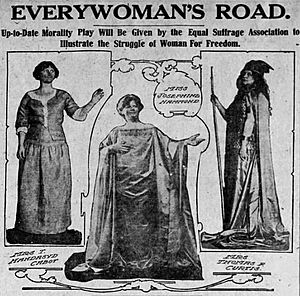Boston Equal Suffrage Association for Good Government facts for kids

The Boston Equal Suffrage Association for Good Government (BESAGG) was an American group. It worked to help women get the right to vote in Massachusetts. BESAGG was active from 1901 to 1920. This group attracted younger members. These members were often more willing to try new things. BESAGG played a big part in Massachusetts. They helped the state officially approve the 19th Amendment. This amendment gave women across the U.S. the right to vote. After 1920, BESAGG changed its name. It became the Boston League of Women Voters.
What Was BESAGG?
The Boston Equal Suffrage Association for Good Government (BESAGG) started in 1901. It was founded by Maud Wood Park, Pauline Agassiz Shaw, and Mary Hutcheson Page. Their goal was to make Boston a better place. They believed women voting would help families and homes. Pauline Agassiz Shaw was a wealthy person. She used her money to help others. She was the first president of BESAGG.
At first, BESAGG worked on many issues. These included helping people in poverty. They also worked on improving prisons. But by 1910, they focused mainly on one goal. That goal was getting women the right to vote. Winning the vote was hard in Massachusetts. The state had a strong movement against women voting. Even efforts to let women vote in city elections failed. In 1915, a state change was voted on. It would have given women the right to vote. But the public voted against it.
How BESAGG Made a Difference
BESAGG was one of the most important groups. It was smaller than others. But it was very active in Massachusetts after 1900. There was an older group called the Massachusetts Woman Suffrage Association (MWSA). Another group was the College Equal Suffrage League (CESL). Maud Wood Park also started CESL. It was for college students and graduates.
When BESAGG began, the women's right to vote movement was slow. Members of BESAGG were from middle and upper-class families. Their early methods were quiet and traditional. But BESAGG looked to British women for ideas. Groups like the Pankhursts used bolder methods. So, BESAGG started trying new ways to campaign.
New Ways to Campaign
Members like Susan Walker Fitzgerald and Florence Luscomb went door-to-door. They visited neighborhoods where many immigrants lived. They handed out flyers in Yiddish and Italian. They also held outdoor meetings. These were often on busy street corners. The meetings caught the attention of newspapers. In 1909, they made headlines. They sold newspapers about women's voting rights on the street. They sold them alongside the regular newsboys.
BESAGG also worked against politicians. They campaigned against those who opposed women voting. This led to two state senators losing their jobs. Roger Woolcott lost in 1912. Levi Greenwood lost in 1913. BESAGG members also took trolley tours. They traveled across Massachusetts. They made speeches at every stop. Margaret Foley was an Irish-American factory worker. She visited factories at lunchtime. She spoke to the workers there.
BESAGG also taught women about government. They wanted women to be smart voters. This way, they would be ready when they could vote. Clara Bancroft Beatley led the Moral Education Department.
By 1914, many groups supported women voting. These included the Democrats and Progressives. Socialists and labor unions also supported it. Massachusetts Governor David Walsh was also a supporter. The 19th Amendment was passed in 1919. Massachusetts was the eighth state to approve it. After this, BESAGG changed its name. It became the Boston League of Women Voters.

